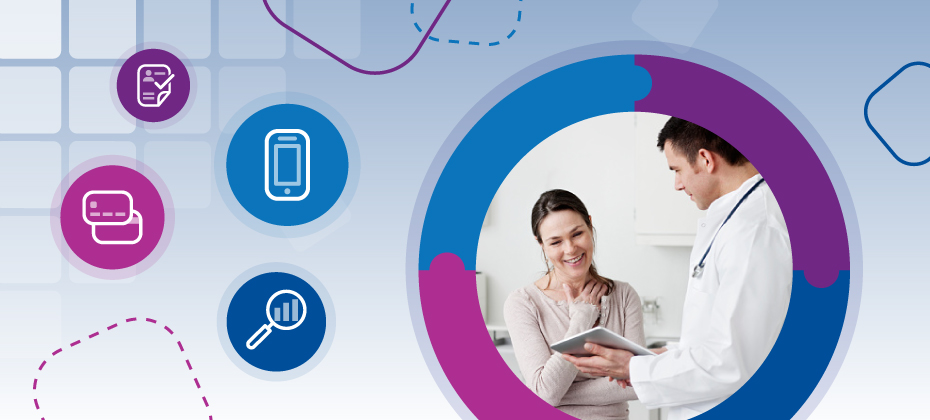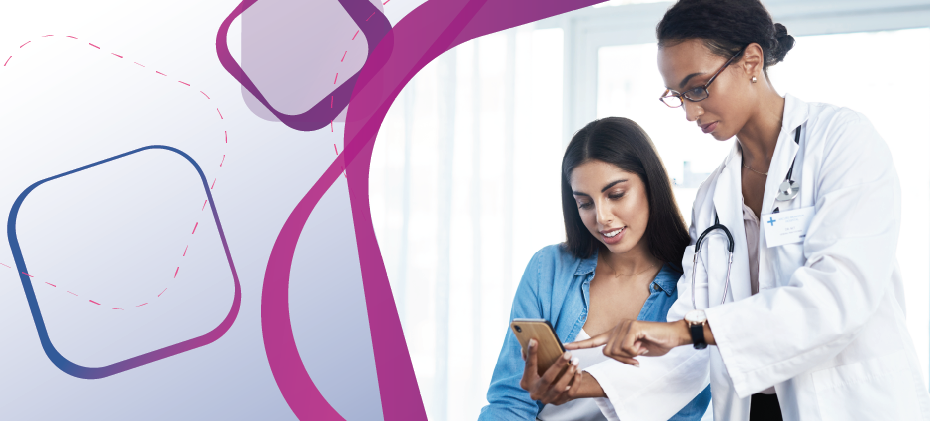Patient Access
Learn how to improve patient access by verifying critical patient information and collecting patient payments prior to service.

The delta variant is still surging – and flu season is about to begin. How can healthcare providers leverage innovative technologies to streamline care and prepare for a potential “twindemic?” The summer of 2021 has not been kind to healthcare professionals. After a brief period of hope that the worst of the COVID-19 epidemic was over, the delta variant started its march across America, flooding hospitals and physician practices with a new wave of seriously ill patients. Autumn and winter look like they might be trouble, too, as delta joins forces with the seasonal flu to form a potential “twindemic.” After a mild season in 2020, many experts are predicting that the flu will reemerge with a vengeance this year as people return to in-person work and school. The combination of the two illnesses could easily overwhelm providers who aren’t prepared with technologies and workflows that allow them to serve patients efficiently and remain responsive to fluctuating demands. As providers look to navigate the coming months, they will need to make sure that they have self-service tools in place to keep patients safe and relieve strain on staff. With a few key digital solutions, resources can be maximized, unpredictable patient volume can be managed effectively, and difficult circumstances won’t slow down operations. Online self-scheduling can improve experiences for patients and staff Online self-scheduling is in high demand because it provides flexibility. patients want to move on with their busy lives without having to sit on hold with a representative. In Experian Health’s recent survey, the State of Patient Access 2.0, more than seven out of ten patients wanted to take the appointment-making process into their own hands, citing the speed and convenience of choosing their own appointments. Providers and physician groups appear eager to oblige. More than 70 percent of providers responding to the survey stated they are planning to offer online appointment tools to improve experiences and manage complex operations as the pandemic continues. The benefits for providers are significant. Online self-scheduling can measurably reduce administrative burdens on staff, allowing practices to reallocate their people power to other high-priority tasks. Giving patients the tools to make appointments may also help to reduce patient no-show rates, which can drain billions of dollars each year from provider organizations. Using self-scheduling tools, patients with transportation issues or concerns about exposure risks may be able to opt for telehealth visits, as opposed to unplanned visits to urgent care centers or the emergency department. This can help protect other consumers and staff from illness while allowing them to manage their own calendars. Mobile patient registration keeps patients safe from exposure during a "twindemic" Shifting patient registration from the clinic to the home can also be beneficial for patients and providers. When patients fill out new forms or update existing information in person, they increase their exposure risk by staying in the waiting room longer than necessary. In contrast, a digital registration accelerator solution offers a quick, touchless, and convenient intake experience on the patient’s own mobile phone. Patients can complete the process in their homes (where they are more likely to have all their personal information at hand), or in the parking lot while waiting for clearance to enter the building. On the provider’s side, automating patient intake improves operational efficiency and avoids errors that come from illegible handwriting and verbal information communicated through masks and plexiglass. Data integrity algorithms and real-time feedback for patients can correct mistakes quickly to ensure high accuracy of patient data – a crucial competency for treatment and reimbursement. Patient portals boost convenience, communication, and security As providers prepare to battle two illnesses instead of just one, practices shouldn’t forget to leverage one of the most important parts of the digital arsenal: the patient portal. Portals are instrumental for staying connected with patients, particularly with the 40% of patients who skipped medical care in the early months of the pandemic. As a complement to necessary in-person care, patient portals offer a convenient way to communicate with providers, complete administrative tasks, and access personal health information at their leisure. Providers must be certain, however, that their portals don’t become avenues for medical identity theft. Healthcare organizations must maintain tight security policies that simultaneously deliver an optimized patient experience. A patient identify-proofing and authentication solution that automates patient portal enrollment while adhering to the high standards of HIPAA and other industry requirements is key. Solid security can reassure patients that sharing digital health information with their trusted providers is safe - fostering more open relationships and leading to better care. Hopefully, fears of a “twindemic” will fizzle as communities continue to take sensible precautions against the spread of COVID-19. However, if the flu does roar back into life, providers must be prepared. Self-service technologies and robust security measures can safeguard practices against the strain of higher-than-expected patient volumes and supporting the continued delivery of high-quality patient care. Learn more about how Experian can help your organization incorporate these new technologies and prepare for a potential "twindemic."

The rising popularity of virtual care seems to be extending itself into other areas of patient experience, including a re-energized consumer preference for digital self-scheduling. In fact, McKinsey & Company reports that telehealth visits and utilization are 38x higher than pre-COVID-19 levels (July 2021). Meanwhile, Experian Health’s State of Patient Access 2.0 survey, released in June 2021, found that 73% of consumers now want to schedule their own doctor appointments online. Interest in self-scheduling is more than a lingering side effect of the pandemic. For providers, it’s a great way to build digital engagement with current and prospective patients – while accelerating internal efficiencies as patient volume increases. A clear preference for patient self-scheduling emerges “The preference for self-scheduling is not surprising when you look at the data,” says Sanju Pratap, Experian Health’s Vice President of Consumer Products, who sat down to talk about leveraging patient scheduling solutions to enhance digital engagement. “Patients are scheduling appointments online at all times of day – right before dinner, early in the morning or at lunchtime. During these uncertain times, self-scheduling is so much easier and safer." Expectations also changed when COVID-19 introduced consumers to self-scheduling for vaccine appointments. “At the same time, providers are cognizant of wanting to reduce patient waiting time when trying to schedule appointments or follow-ups – especially in care settings where they’re trying to minimize the time patients are in the office,” says Pratap. “Their resources are pretty slim these days. Any move toward efficiency is appreciated.” Self-scheduling creates a better digital patient experience—and a competitive advantage Now, providers are contending with a large number of consumers who moved during and after the pandemic and increased patient volume following a year or more of deferred care. Self-scheduling is often the first point of interaction. “I may Google a new provider to learn more about their practice,” says Pratap. “If I’m on their website and I see a “schedule now” button, I’m likely to try it, rather than waiting weeks or months to call the office to see whether they take my insurance or have an appointment for me.” That first point of contact can turn into a competitive advantage: “Does the orthopedic practice down the street offer online scheduling that makes it easy for other providers to refer to them—and easy for patients to schedule their own appointments? Providers that do are going to get new patient revenue and increase patient loyalty. They’re going to keep more of their existing patients if they meet consumers where they want to be.” Providers can create processes that exceed their own expectations Many providers still have their doubts about self-scheduling. “We often hear, ‘No system is going to understand the nuances of my scheduling template,’” says Pratap. These doubts aren’t totally unfounded. “Accurate appointments require a deep understanding of scheduling protocols. In the past, individually scripted schedulers had binders of questionnaires that they made notes on, relied on Post-It notes, and/or institutional knowledge. As you can imagine, this can be very inefficient, error-prone, and not the best experience for patients, providers or staff.” If humans have a hard time managing online healthcare appointment scheduling, what hope is there for automated systems? In fact, digital questionnaires and electronic medical records (EMRs) can streamline scheduling and provide a clean, seamless experience for all parties involved. The key: building a patient self-scheduling system without blind spots To make scheduling more efficient, questionnaires must be consistent, but also flexible enough to accommodate a variety of providers, locations and specialties. Patients and access coordinators should be able to look for appointments across providers within a single view. If one provider is not available within a patient’s requested timeframe, a system could suggest another qualified provider. In doing so, systems can avoid scheduling imbalances that overload some providers, while under-scheduling others. Pratap shared additional ideas for avoiding blind spots: Remove friction from the patient journey end to end. For example, if you require a sign-in to your patient portal to view appointments, you may discourage consumers who don’t want to create new sign-ins just to view availability. Create a system that works for many users. “It’s not just patient self-scheduling you have to consider, but also the call center, the patient portal and anyone that’s leveraging an API to book into a provider’s schedule,” says Pratap. “Scheduling tools should make it easy to see availability across multiple providers and locations, and allow patients to see accurate availability and easily book, no matter who you are or how you accessed the system.” Revaluate pre-visit messages sent after appointments are made. Capture all the information you need to ensure the patient’s registration process and visit goes smoothly. Build in accommodations for unique needs. While automation can help streamline scheduling, it’s important to understand every patient’s individual needs. If necessary, staff can step in and take the reins on scheduling. For example, staff can manually accommodate appointments for an older patient who suffers from chronic issues and needs more time with their doctor. Don’t rely solely on out-of-the-box solutions. Using the scheduling functions that come with different types of EMRs may be tempting. However, making the additional effort to create a process that is accurate, efficient and flexible—and encourages digital patient engagement—increases the value of a patient scheduling solution exponentially. Measure progress and mine data to continue optimizing Scheduling isn’t just your digital front door. It also has the potential to make—or lose—revenue. “Some providers worry about patients booking the wrong appointments and taking time away from other patients,” says Pratap. “Their concerns are valid; these time slots are valuable.” “One of the metrics we use to gauge how successful our scheduling systems are is by looking at the rescheduling rate,” Pratap explains. “We look at how many appointments need to be re-booked because the wrong provider or appointment type was chosen and filter out appointments that were re-booked for other reasons. By using this information, we can create systems where re-booking is rare.” Monitoring data also helps providers stay ahead of fluctuating needs and preferences. “When you’re choosing a scheduling solution, ask what reporting and analytics are built-in,” says Pratap. “You want to be able to find out, for instance, what availability looks like across your practice—and whether it’s the reason patients aren’t scheduling with you. Analytics and insights can be layered on top of data to help you optimize the patient experience and keep your practice running efficiently.” Contact us to see how Experian Health can help streamline patient scheduling for your organization.

This is the second in a series of blog posts that will highlight how the patient journey has evolved since the onset of COVID-19. This series will take you through the changes that impacted every step of the patient journey and provide strategic recommendations to move forward. In this post, we explore how 24/7 self-scheduling can help healthcare providers adapt to the post-pandemic digital landscape. To read the full white paper, download it here. If there’s one digital tool that punches above its weight in the healthcare industry, it’s online self-scheduling. This simple concept – allowing patients to book their own appointments online – resolves many sticky issues throughout the entire patient journey. It drives patient satisfaction, acquisition, and retention. It boosts staff efficiency and smooths out bumps in the revenue cycle. No-shows and delayed care can be minimized, leading to reduced costs and far better health outcomes. All of that was true before the pandemic. However, when COVID-19 hit, self-scheduling was a gamechanger. When more patients wanted to manage their healthcare online, and staff were forced to work remotely, online medical scheduling was convenient and safe. Now, the return on investment is even higher. As patients struggle to overcome growing barriers to care, and providers wrangle with soaring volumes of returning patients, the digital front door must remain open. How can providers leverage the benefits of 24/7 digital self-scheduling seen over the last year or so, and create a digital patient experience that’s fit for the future? Consumers schedule appointments differently now – and they don’t want to go back Healthcare has been playing digital catch-up to other industries for much of the last decade. Consumers have long grumbled about archaic registration processes and the absence of digital tools seen frequently in other sectors. The urgent reconfiguration of the healthcare consumer experience over the last year means many of those missing digital options are now available. Instead of calling to make an appointment during office hours, patients can use 24/7 online scheduling platforms – accessible any time, from any device. Having had a taste of convenience and control, consumers expect online scheduling to continue beyond the pandemic. According to a new Experian Health study, nearly three-quarters of consumers want to continue to schedule their own appointments online. More than eight in 10 prefer an online or mobile-related registration experience. Rather than wait in a long customer service queue, patients can make, cancel, or reschedule appointments with the push of a button. Patients of all ages like having a flexible and frictionless way to manage their care, so why would they choose a provider that doesn’t offer online self-scheduling as part of the mix? 24/7 self-scheduling reduces barriers to care In addition to meeting consumer expectations, 24/7 self-scheduling also helps providers overcome many new and existing consumer challenges in the wake of the pandemic. Patients can be blocked from accessing the care they need for all sorts of reasons – financial worries, lack of transportation, lack of time to phone and book appointments, and/or cultural barriers to seeking support. As with many public health challenges, those who experience the greatest social and economic challenges have also been hardest hit by the pandemic. While many of these issues aren’t easily resolved by any one organization, self-scheduling does offer a route around several barriers to care. By simply offering a more flexible way to book and cancel appointments and interact with their provider, self-scheduling platforms allow patients to make plans in a way that fits their circumstances. Inconvenient business hours and long waits for available appointments become less of a concern. And with automated patient outreach, providers can make the process even easier, by sending text or email reminders to specific groups of patients to make sure they get the care they need. Digital self-scheduling eases call center bottlenecks Giving patients the ability to book their own appointments online also eases the burden on call center staff. Setting up staff to work remotely, while managing an influx of patients scrambling to book COVID-19 tests and vaccinations, created many pain points throughout the pandemic. First come, first serve scheduling options create bottlenecks in call volume, and when patients can’t get through to cancel appointments they can no longer attend, those slots sit unused - wasting physician time. As patients look to reschedule deferred care, 24/7 self-scheduling can minimize these bottlenecks by relieving pressure on call center staff and spread the load across multiple channels. Call center agents can reallocate their time to higher-priority inquiries. Call times can be cut because agents will have integrated access to disparate electronic health records and project management systems. Training time can also be reduced through simplified online systems. It’s no wonder that 71% of providers offer (or plan to offer) online self-scheduling options. Building a self-scheduling ecosystem that’s fit for the future Digital self-scheduling systems implemented during the pandemic should become a permanent feature in patient access. Providers that want to create an attractive patient experience should expand their digital self-scheduling offering beyond simply booking appointments. Multiple specialty services can be integrated into the scheduling system to streamline referrals. Telehealth services that gained so much ground over the last 18 months can be connected to online scheduling tools so they’re fully embedded going forward. Digital payment options and coverage functions can also be linked to scheduling platforms, for a seamless end-to-end digital patient experience. Find out how Experian Health’s 24/7 online patient scheduling software can help your organization deliver an optimal patient experience, improve call center productivity, and reduce revenue loss as the healthcare industry adapts to the new digital landscape. Download our white paper to get patient-provider perspectives on self-scheduling and other digital trends.

In November 2020, Experian Health conducted a survey to capture consumer and provider attitudes regarding patient access. At the height of the pandemic, patients welcomed telehealth services and maintained their distance from hospital waiting rooms. Providers scrambled to implement and provide digital services that would help them maintain quality care for their patients. In June 2021, we revisited these questions to see if healthcare providers and patients changed their views on the state of patient access: The pandemic has forced rethinking how to “do” healthcare in the digital age. Patients want flexible, convenient, and contactless care; providers need to continue providing these services. Download the white paper for the full survey results and get strategies to plan for the future of healthcare.

COVID-19 changed every aspect of the patient journey – placing unprecedented demands on the healthcare system and accelerating the need for digital transformation industry-wide. Telehealth, touchless engagement, and self-service scheduling became the new normal; however, this created new stress on operations, administration, and finance. While this new normal comes with many challenges, data and digital tools have created greater accessibility, engagement, transparency, and control for patients and providers. In this blog, we examine COVID-19’s impact on the patient journey and explore the digital tools and data that are helping the healthcare industry recover and thrive. To get more insights, read the full whitepaper here. COVID-19 strained the healthcare system more than ever before. To say that COVID-19 challenged the healthcare system is a massive understatement. Seven in 10 patients deferred or canceled treatments during the pandemic, causing disruptions to both revenue and patient engagement. Even behind the scenes, novel diagnostic codes and new sources of information—together with rising inpatient volume and government intervention—affected costs, billing and reimbursements at scale. Patient-provider relationships became much more complex. Many people moved, changed jobs and changed insurance during the pandemic. In fact, an estimated 40 million Americans lost work during the pandemic and just over half of all workers in North America plan to look for new work in 2021. As a result, relationships between physicians and patients became disrupted. While re-engagement is critical for providing care, simply finding patients remains a challenge. The digital experience raised patient expectations. As consumers turned to technology to cope with changes, digital engagement increased in healthcare services and elevated consumer expectations. This trend began before the pandemic: A pre-COVID-19 AARP survey of older adults (50+) found that a majority would prefer to have their healthcare needs managed by a mix of medical professionals and technology. During the pandemic, patients used telehealth to access care from home, mobile registrations to avoid filling out paperwork in the waiting room and digital payment options that made paying bills simple and seamless. Now that patients have experienced telemedicine, self-service scheduling and easy digital payments, there is no going back. Expectations have changed permanently, and providers that don’t offer an updated patient experience may suffer by comparison. Opportunities for better outcomes: transforming the patient journey with digital transformation We looked at key parts of the patient journey where technology is helping healthcare providers engage and care for their patients successfully across the marketing, scheduling, registration, authorization, treatment, claims and payment. Here are a few strategic opportunities for providers to consider post-COVID: 1. Use smart data for better outcomes Third-party data is helping providers find and re-engage patients, deliver more holistic care and facilitate better financial outcomes. For example, integrating data on social determinants of health (SDOH), can provide physicians with a more holistic picture of non-medical factors that may influence medical outcomes, such as a patient’s socioeconomic status. SDOH data can also shine a light on a patient’s ability to pay, which in turn may inspire a wider range of payment options so that more patients can afford care, and more providers can avoid write-offs. 2. Continue using technology and automation for the recovery to come Using digital self-service applications for registration does more than just provide the patient-friendly option of completing paperwork at home (instead of the waiting room). It also eliminates the need for staff hours spent inputting information, reduces the potential for error, and improves efficiency. Advances in automation make it possible for providers to reduce the effort of manual tasks - like sorting through patient records from disparate sources to create a single, comprehensive patient file, or gathering the information necessary to revisit claims authorization for deferred care. Across the board, digitalization provides greater transparency, flexibility, and seamless experiences for patients and providers alike. 3. Clear the path for payments Going digital can help patients and providers better navigate the patient journey, especially when it comes to payments. As many as half of nonretired adults expect long-term financial effects as a result of the pandemic. This makes it more imperative than ever to improve and accelerate authorization, claims, and payment processes so that both patients and providers have a clearer understanding of how care will be paid for. Accurate patient estimates, coverage discovery, automated authorizations, and payments all play a role in creating a better financial experience going forward. Digital transformation gains traction as we look to the future Although the digital transformation was already underway before COVID-19, the pandemic has accelerated the need for data, automation, and self-service tools. Find out how Experian Health can help your organization meet the data challenges of the post-COVID-19 patient journey by downloading our white paper.

"93% of providers say creating a better patient experience remains a top priority, up 3% from last year." - Experian Health's State of Patient Access, June 2021 In November 2020, we surveyed patients and providers for their sentiments on how patient access changed because of the pandemic. During this time, patients welcomed the convenience and control that came with digital, contactless care. Providers knew they needed to improve their digital front door to withstand the financial impact of COVID-19, but implementation was difficult for many organizations. Six months on, and millions of immunized Americans later, the pandemic landscape shifted again. In June 2021, we revisited these questions to find out if patient and provider views have changed - in our State of Patient Access 2.0. Now, patients tell us they feel more confident about returning to facilities, though they still want the flexibility and convenience of digital scheduling, registration, and payment options. Providers feel a growing urgency to make sure online services are sufficiently agile enough to withstand any future surges in COVID-19 case numbers. The findings of the survey reveal four major opportunities to rethink how we “do” healthcare. By innovating and building on the digital advances made possible during the pandemic, providers can create better patient access experiences for the future. To start, providers should: 1. Match consumer expectations for convenient and flexible patient access Our recent survey shows that the pandemic has cemented consumer expectations around convenient access to care. Digital and remote channels for scheduling appointments, completing pre-registration, and making payments have become the new baseline in patient access. Nearly three quarters of patients told us they want to schedule their own appointments online. Providers know this: 93% say creating a better patient experience remains a top priority, up 3% from last year. Online self-scheduling can help providers continue to meet their patients’ demands for flexibility and convenient access to care. Patients can find, book and cancel appointments whenever and wherever they prefer. It’s also a win for providers, who can expect to see a drop in administration errors, no-shows, and denied claims. 2. Streamline prior authorizations as more patients return to care Interestingly, new data reveals that patients are less anxious about in-person care. In 2020, 40% of patients were uncomfortable coming into waiting rooms and seeing their doctor in person. Now, only 16% say they wouldn’t be comfortable in a waiting room. As more patients rush to reschedule deferred care, providers are faced with the challenging combination of higher patient volumes, patients jumping health plans as a result of job losses, and changing payer rules around prior authorizations and coverage checks. Automated pre-authorization and automated coverage checks can relieve the pressure, and help providers save time and resources. 3. Promote price transparency for fewer missed payments An encouraging piece of insight from our latest survey reveals that far fewer patients say they’ve been surprised by their final medical bill. In 2020, more than 50% received a final figure that differed significantly from estimates. Six months later, that figure has dropped to just 14%. Price transparency remains important, and the gap between estimated and final costs seems to be closing. More providers are offering patient billing estimates, with 9 in 10 agreeing that accurate estimates increase the chance of bills being paid on time. Many are also giving patients more options to pay bills earlier in the journey, which has helped to minimize the risk of late and missed payments. Easy and accessible digital options are featured heavily in acquisition and retention plans, and can help drive financial recovery. 4. Tighten up data strategies with better security, quality and insights While our first survey revealed that the sudden shift to digital-first patient access was a shock to the system for many providers, the second study shows that both patients and providers are settling into digital ways of working. But as these digital services become the new baseline, providers must make sure their data strategies are fit for purpose, and prioritize data security, quality and insights. Moving forward, a multi-layered approach will help providers authenticate and secure patient identities. When these identities are enriched with information about how patients are affected by the social determinants of health, providers will be better positioned to offer personalized patient access experiences and support marginalized groups. The future of healthcare is digital. Is your organization prepared? It’s clear from our recent survey that the digital trends that emerged in 2020 are set to continue throughout 2021 and beyond. Download the State of Patient Access 2.0 white paper to get the full survey results and explore how data and digitalization can power a 24/7 patient access experience in your healthcare organization.

As the country strives to ramp up the pace of COVID-19 vaccinations, providers need to take new approaches to drive registration volume. Healthcare experts are increasingly concerned about the rapid spread of the highly contagious delta variant, which now makes up over 83% of COVID-19 cases. This variant is estimated to be 60% more transmissible than previous strains, and while vaccination doesn’t eliminate the risk, it does reduce the likely severity of infection, which is better for both individuals and health services. Ramping up the vaccination program and ensuring that a large proportion of the population receives the injection just became a lot more urgent. This is also critical for vaccine management plans as the U.S. looks to offer and roll-out booster shoots later this year. The initial vaccine rollout was plagued with issues, many of which remain unresolved. An uneven rollout, confusion over where to get vaccines, and logistical obstacles with preparation, distribution and funding at the state level meant the program got off to a slow start. Consumers were deterred from registering due to inefficient scheduling systems, while others were left frustrated by basic user interface challenges. And for those less familiar with digital technology, the shift to online platforms took some getting used to. Now, with the delta variant taking hold, and vaccine hesitancy on the rise, healthcare providers need to consider how digital technology can make vaccinations more accessible, rather than becoming the obstacle. Improving the user experience through digital tools and automation can reduce barriers to care, drive up vaccine registrations, and ultimately lead to better outcomes for individual and population health. Poor UX creates avoidable barriers to scheduling care One of the major accessibility challenges for consumers was being able to schedule vaccine appointments. In the initial rush to get vaccinated, demand outstripped supply, and online scheduling systems struggled to bear the load. Some providers tried to rely on email booking systems or third-party event schedulers – which resulted in communication errors, delays, missed appointments, and huge burdens on call center staff. For individuals who were unable to use online systems due to limited internet access, disability, or unfamiliarity with the technology (for example, as reported by some older people), the inaccessible and non-intuitive user interfaces created a digital divide. The poor user experience also contributed to some individuals feeling hesitant about seeking the vaccine, eroding their trust in the system as a whole. Efforts to increase and ramp up vaccination rates will be much more successful if the scheduling process is simplified. Frictionless scheduling and registration can drive up vaccine rates With the right data and digital tools, many of these patient access challenges can be resolved. Frictionless self-scheduling and streamlined registration processes can make it easier for people to book appointments and register for the vaccine. For example: Online scheduling platforms allow patients to book and reschedule vaccine appointments whenever and wherever it’s most convenient, as part of a multichannel approach. Automation enables providers to create an outreach list of patients who may be waiting for the vaccine, and send automated reminders by text or email. These can be used to disseminate accurate information to alleviate vaccine hesitancy. The messages can also be personalized to follow the patient’s individual communication preferences. Consumer data and analytics on the social determinants of health can be folded into communications, to tailor information to specific segments of the population who may have been adversely affected by barriers to care. Scheduling software can pull together real-time booking and registration data into a single, holistic view of patient access, whether patients booked via online platforms, call centers or in provider offices. This will help alleviate bottlenecks and make better use of staff resources. Digital tools can improve the patient experience and supercharge vaccine management plans, but only if they are implemented properly. Experian Health’s Director of Product Management, Liz Serie, says, “The old way of doing patient intake involves piles of paper, clipboards and long waits in the waiting room. The new way involves automation, pushing relevant and personalized information to patient’s devices, and seamless data management to initiate the patient journey. It’s a reassuring, simple and reliable user experience, especially as many still need to be vaccinated. And as patient volumes drive back up, investing in a welcoming digital front door is critical.” The future of patient access is digital, and providers that get their systems up and running effectively now will reap the benefits in the long run. Find out more about how data and digital tools can make vaccine appointment scheduling a breeze for your patients and patient access team.

Consumer-led care hit its stride during the pandemic. COVID-19 unlocked healthcare’s digital front door, giving patients more control over how and when they schedule and manage appointments. Unfortunately, while digital patient access has made navigating the healthcare system more convenient and flexible in many ways, consumers are discovering that one of the more frustrating aspects of the healthcare experience has failed to keep pace with scheduling, payments and other digital advances: registration. Waiting rooms. Paperwork. Misplaced insurance cards. Confusing copays. More paperwork! A hassle before the pandemic, registration has become even more challenging for staff and patients in the context of “contactless care.” With more patients starting to come back through the door as a result of vaccination programs and rescheduled elective procedures, there’s an opportunity for providers to smooth out the kinks in the registration experience. Vaccine “hesitancy” has exposed wider issues in patient registration Headlines suggest that large numbers of patients are fearful of being vaccinated against COVID-19. But dig a little deeper, and the issue is more complex. Many patients do want to be vaccinated, but struggle to navigate complicated registration websites, and therefore aren’t showing up for their shot. The Kaiser Family Foundation reported in January that two thirds of patients were unsure of how to access the vaccine. The high volume of patients having trouble getting the information they need is shining a light into the dark corners of the registration process, where improvements have long been needed. Improving the patient registration process isn’t just a pandemic problem While it’s true that COVID-19 is driving the push for online patient registration, improving the overall experience offers wider, longer-term benefits to patients and providers: A convenient and consumer-friendly registration experience Online registration is easier, faster and simpler for patients. With 73% of consumers saying they want to manage their healthcare admin through patient portals, convenient self-service solutions are a trend that’s here to stay. (Find out more about consumer attitudes to patient access in Experian Health’s Patient Access Survey.) More accurate patient data and fewer duplicate records When consumers are the ones responsible for entering their patient information, and when they can do it in a time and place that suits them best, that data is far more likely to be accurate. Not only does this create a better patient intake experience, it also reduces the risk of patient identity errors and duplicate records. With a text-to-mobile registration tool, patients can begin the process with one click, and then easily verify and edit information to make sure their records are up to date and correct. Operational efficiencies and better claims recovery Beyond the customer experience, improved registration can reduce the risk of denied claims, because the data is processed more accurately and quickly, and can be automatically verified against comprehensive datasets. Patients can also choose to pay copay amounts upfront through online registration tools, which makes bad debt far less likely, and improves the overall revenue flow. Safer and smoother registration during flu season COVID-19 put unprecedented pressure on registration processes. But more streamlined systems with remote, mobile-friendly registration tools will make a typical flu season more bearable for patient access staff and patients too. Patients and staff have suffered through cumbersome registration processes for years. Perhaps one unforeseen benefit of the COVID-19 pandemic is that the days of sitting in busy waiting rooms, filling out multiple forms, will be a thing of the past? Discover how Experian Health’s patient intake solutions could help your patient access department create a registration experience that matches today’s consumer expectations.

“The entire healthcare industry was turned upside down by the pandemic. Procedures were pushed back, insurance companies gave policy holders a lot of mixed information. It has been a mess.” This is what one healthcare executive told us when we surveyed patients and providers on the state of patient access, in June 2021. Changing prior authorizations requirements were particularly messy, and as more patients return to care, there’s a risk they’ll become even more chaotic. During 2020, many in-person healthcare services were canceled, delayed, or avoided for fear of infection. Now, patients feel more comfortable about returning for care. When we first surveyed consumers in November 2020, 58% said they’d wait until COVID-19 subsides before rescheduling. In June 2021, only 19% said they’d wait. Canceled procedures have dropped by half, and while the opportunity to recoup lost revenue is a relief for providers, processing prior authorizations for the sudden influx of patients is a worry. Two thirds of providers say they find it difficult to keep track of changing pre-authorization requirements. Two in three also expect to face issues in securing authorizations for scheduled elective procedures, up from just over half last year. Embedding accurate and efficient workflows will be paramount as patient volumes rise, which means it’s time to rethink the archaic manual processes that often result in delays, errors, and non-compliance. Could automation offer a mess-free way to manage the growing challenge of prior authorizations? Manually managed prior authorizations cost time, money, and quality of care Even before the pandemic, prior authorizations were a thorny issue for healthcare organizations who wanted to offer the best possible care to patients, without risking denied claims. According to the Medical Group Management Association (MGMA), 80%-90% of medical groups say prior authorization requirements have grown year over year. In an ideal world, prior authorizations protect patients from undergoing therapies that are overpriced, ineffective or unnecessary. They assure providers that they’ll be reimbursed for the services they deliver, and confirm that treatments are high-quality, evidence-based, and safe. In reality, while prior authorizations can help incentivize value-based care, the admin and financial burden for providers is growing exponentially. Frequent changes, increasing denials, and lengthy negotiations with payers mean many providers need to employ additional full-time staff to handle prior authorizations. As the cost of drugs soars, they’re forced to lay out huge sums and cross their fingers as they wait to recoup the costs. There was a hint of respite at the peak of the pandemic, when payers lifted many requirements, or extended authorizations already held on file. But these changes took time to filter through, and some providers continued to lose up to two entire business days per week to prior authorizations work during the pandemic. Now, as the pandemic starts to settle, those requirements are back (and growing), and providers are scrambling to re-join the dots using their old, manual processes. As patient numbers surge, traditional manual methods for such an admin-heavy process are straining under the pressure. With so many accounts to authorize, the need for an automated solution is even more apparent. Leveraging automated solutions for speedy, accurate prior authorizations To ensure patients get the care they need and to keep a lid on further revenue loss, hospitals and medical groups should consider tapping into automated authorizations engines. With an integrated Authorizations management system, you can initiate more authorizations in less time, run automated status checks to avoid rescheduling care, keep abreast of changing payer rules, and avoid unnecessary reworking of claims. Users are guided through the workflow, which auto-fills essential real-time payer information. Patient information is populated by the SmartAgent feature, so pre-certification can be progressed quickly behind the scenes. Users only need to step in when clinical questions pop up. Notice of Care (NOC) generates a worklist of all pending patient encounters, to ensure that no payer notification requirements for notice of admission, observation or discharge are missed. Staff can escape the time-suck of repeatedly checking payer websites or calling up payers to verify yet again whether a patient encounter qualifies. Say goodbye to Excel spreadsheets and lengthy calls to payers For organizations worried about rising patient numbers choking their existing manual workflows, switching to an automated system could be a timely move. Chasing paperwork is never a good use of resources, and with the lingering possibility of pandemic flare-ups, automated authorization inquiries could help minimize time spent on tedious manual tasks and running checks with payers. Find out more about how Experian Health’s Prior Authorization software could help your organization minimize the risk of missed reimbursements, and give your team the breathing space needed to focus on maximizing support for patients returning to care.